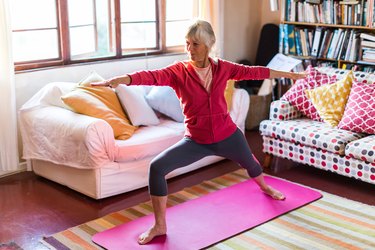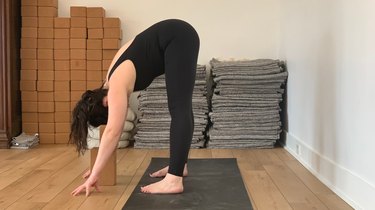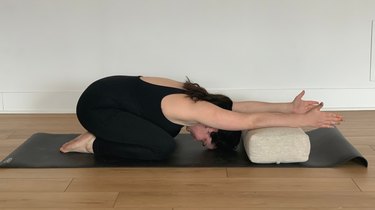
Menopause has become synonymous with its symptoms — hot flashes, sleep disruption and mood changes among them. But that doesn't have to mean you're miserable all the time. Adding even a few yoga poses to your daily routine is a great way to ease some of these side effects naturally.
"By making space for the practice in your daily routine you will create new pathways that will help you physically, mentally and emotionally regulate yourself and navigate this tumultuous season of life," Melie Purdon, RYT-300, yoga teacher and prenatal expert at YogaRenew Teacher Training, says.
Video of the Day
Video of the Day
And the benefits of yoga extend beyond the years of "the big change:" A June 2016 study in Complementary Therapies in Medicine reports that Hatha yoga (slower, more controlled movements and breathwork) promotes positive mental and physical changes in postmenopausal people.
"When it comes to specific symptoms — such as hot flashes — you will want to slow down," Purdon says. "It may not be the best day for an invigorating flow. Instead, opt for restorative poses where the body lays supine (on the back) supported by bolsters or blocks, and begin to breathe."
Below, Purdon demonstrates four of the best yoga poses you can do as you approach menopause and as you go through it.
Tip
“The true benefits [of yoga for menopause] will show with consistency and commitment to ... connect to your changing body and tune inward,” Purdon says. So try to set aside at least 5 minutes a day.
1. Revolved Hero’s Pose (Parivrtta Virasana)

- Kneel on the floor with a block or two (widest side down) between your ankles. The tops of your feet and shins should press into the mat.
- Sit back onto the blocks.
- Place your right hand behind you on a block against your lower back and rest the top of your left hand against the outside of your right thigh.
- Using your thigh as a lever, turn your chest to the right as far as is comfortable.
- On your inhale, lengthen your spine upward from your tailbone to the crown of your head.
- On your exhale, soften your abdomen and turn your rib cage around the spine.
- Keep your neck long and your shoulders away from your ears.
- Slowly return back to center before twisting to the other side.
“Revolved poses and twists are known to help alleviate bloating and promote healthy digestion,” Purdon says.
If your knees are sensitive, she recommends placing a folded blanket under your knees and shins.
2. Standing Forward Fold (Uttanasana)

- Stand on your mat, feet hip-width apart. Keep your toes long without gripping them. Keep your hips in line with your heels and the weight of your body forward.
- Fold over your legs, leading with your heart.
- Let your head, neck and shoulders relax.
- Rest your head on a block or two. If blocks aren’t enough to bring the floor to you, you can use a chair instead.
“As a member of the forward-fold family, uttanasana is a great way to quiet your mind and relax the muscles of your face,” Purdon says. And if you do this pose regularly, it can help alleviate the mental fogginess associated with menopause, as it encourages blood flow to your brain, she says.
3. Child's Pose (Balasana)

- Kneel on the floor, then sit on your shins with your knees several inches apart and toes together.
- Place a bolster (or two) or a few pillows or folded blankets between your knees.
- Fold your torso forward between your thighs.
- Rest your forearms over a bolster.
“As a forward-fold variation, this pose takes the hamstring flexibility out of the equation and helps relieve mental overstimulation and migraines,” Purdon says. “It can also help reduce constipation and bloating.”
4. Legs Up the Wall (Viparita Karani)

- Place a bolster long ways against a wall with a folded blanket on top.
- Sit sideways on the blanket with one hip touching the wall.
- Place your hands on the floor behind you.
- Roll onto your back as you swing your legs up the wall. Your lower back will be supported by the bolster and your butt will be against the wall (or as close to it as is comfortable on your legs).
- Let your spine and torso melt into the props. Let your abdomen soften and your chest relax. Rest your arms by your sides.
“The hardest part of the pose is to get into it,” Purdon says. “But once you are in, it requires no effort.”
Legs up the wall is one of the most effective poses for quieting your mind and body. It can help relieve restless leg syndrome, return blood from the legs to the heart and calm your mind, promoting restful sleep, Purdon says.
Tip
“It’s never too late to start practicing yoga!” Purdon says. “There is so much more to this practice than the pretzel poses. Don't let the tip of the iceberg intimidate you or deter you from looking into yoga to help you through this season of life.”
- Melie Purdon, yoga teacher at YogaRenew Teacher Training
- Evidence-Based Complementary and Alternative Medicine: “Effectiveness of Yoga for Menopausal Symptoms: A Systematic Review and Meta-Analysis of Randomized Controlled Trials”
- The Journal of Obstetrics and Gynaecology Research: “Impact of yoga intervention on menopausal symptoms-specific quality of life and changes in hormonal level among menopausal women”